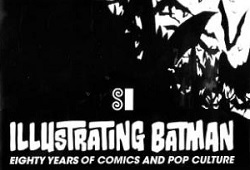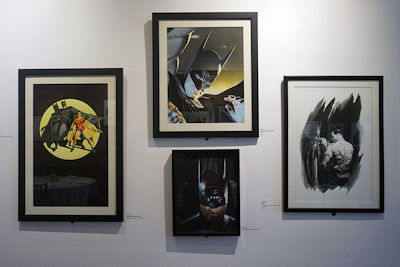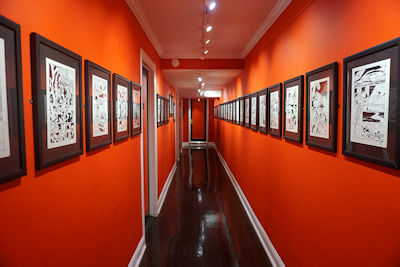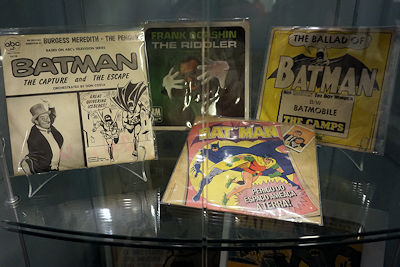
“Na, na, na, na, na, na, na, na, na, na, na, na, na, Batman!”
For many, the Batman television show of the 1960s brings back childhood memories of superheroes just as much as the comic books from which the character originated. For others, it’s the artwork of Neal Adams and Frank Miller that epitomize Batman, and for still others, it’s the films of Tim Burton and Christopher Nolan that will forever be associated with the Dark Knight.
In many ways, this is the true superpower of Batman – that although created in 1939, the character continues to resonate well into the twenty-first century precisely because he has been able to evolve under the tutelage of so many creative heavyweights. As a commemoration of this ability to remain relevant for decades, the New York Society of Illustrators celebrated the Dark Knight in 2019 with an exhibit entitled Illustrating Batman: Eighty Years of Comics and Pop Culture that contained original artwork from over fifty comic book artists who have left their mark on the Caped Crusader.
Although early contractual obligations granted sole credit for the creation of Batman to artist Bob Kane, the character was actually a conglomeration of efforts of not only Kane but writer Bill Finger and artist Jerry Robinson as well. It was Finger that Kane first approached about his idea for “the Bat-Man,” for instance, and Finger immediately offered feedback that transformed Kane’s initial drawings into the Batman that we know today.
It was Jerry Robinson, meanwhile, that added sidekick Robin in addition to a host of supervillains that remain just as famous as the Dark Knight himself, including the notorious Joker. Thus right from the beginning of his existence, Batman was never the result of one solitary vision but a committee of creatives instead. As the years and decades progressed, additional writers and artists added to the mythology and mystique of the character, ensuring that the Dark Knight would continue as one of the most popular superheroes of all time.
Within the walls of the New York Society of Illustrators’ galleries at 128 East 63rd Street – a location that the non-profit organization first occupied in 1939, the same year that Batman premiered in Detective Comics #27 – examples of both the artwork and writings of this eclectic conglomeration of creatives were on display during Illustrating Batman, providing awestruck admiration as well as remembrances for fans regardless of which incarnation of the Caped Crusader that they most connected.
In addition to the aforementioned Bob Kane, Jerry Robinson, Neal Adams, and Frank Miller, original artwork from such legendary creators as Carmine Infantino, Alex Ross, David Mazzuchelli, and Jim Lee were likewise showcased. The popular Batman: The Animated Series, meanwhile, was represented by the original designs of Bruce Timm, while a collection of posters, toys, and other pop culture paraphernalia gave the Batman television series of the 1960s its proper due.
Although diverse in scope from an American perspective, the second floor MoCCA Gallery at the New York Society of Illustrators added an international element with the first ever United States showing of original “Bat-Manga” from Japan. The popularity of the Adam West Batman television show stretched across the Pacific Ocean in the 1960s, resulting in Shōnen King magazine securing a license fromDC Comics to create a manga adaptation of Batman.
The series only lasted one year – from April 1966 through May 1967 – and remained relatively unknown in the United States until American artist David Mazzuchelli stumbled across it while attending comic book conventions in Japan during the 1990s.
Mazzuchelli told Batman enthusiast Chip Kidd about his discovery. Kidd – a graphic designer who created the iconic Jurassic Park emblem for the original 1990 book by Michael Crichton – eagerly delved into the Japanese world of Batman shortly thereafter, and published Bat-Manga! The Secret History of Batman in Japan in 2008.
DC Comics, meanwhile, collected the complete “Bat-Manga” series in a three-volume set a few years later. The Society of Illustrators then added to the resurrection of this lost piece of Batman history with its showcase of original artwork from manga artist Jiro Kuwata at the Illustrating Batman exhibit over the summer of 2019.
“To a true fan, Batman represented a defender, someone who would not only stand up to abstract villains but to bullies and all those who might cause harm to average kids like us,” Batman collector Robert L. Reiner reflects in the accompanying Illustrating Batman exhibition guide. “He didn’t care that we liked to read, appreciated colorful and dramatic art, or that we loved to gather with our friends to share our glee when a new issue arrived. We were all little Robins just hoping that we’d get a needed break from school, our chores at home or just the ordinary lives we led as young people in a changing world.”
Although not all Batman fans may have the exact same recollections, the sentiment found in the words of Robert Reiner reflects those of all Batman fans nonetheless. It doesn’t matter if one is partial to the original Batman of Bob Kane, Bill Finger, and Jerry Robinson, the later efforts of Neal Adams and Frank Miller, Batman: The Animated Series, or even the portrayals of Adam West, Michael Keaton, and Christian Bale, Batman has left an indelible mark that cannot be erased.
Batman, after all, was never the creation of one individual but instead evolved over years and decades through the efforts of a multitude of artists and writers, each influencing not only the character but its ever-growing legion of fans as well.
Anthony Letizia





